Elche
Elche (/ˈɛltʃeɪ/,[2] Spanish: [ˈeltʃe]) or Elx (UK: /ɛltʃ/,[3] US: /eɪlʃ/,[4] Valencian: [ˈɛʎtʃ])[lower-alpha 1] is a town and municipality of Spain, belonging to the province of Alicante, in the Valencian Community. According to 2014 data, Elche has a population of 228,647 inhabitants,[5] making it the third most populated municipality in the region (after Valencia and Alicante) and the 20th largest Spanish municipality. It is part of the comarca of Baix Vinalopó.
Elche
Elx | |
|---|---|
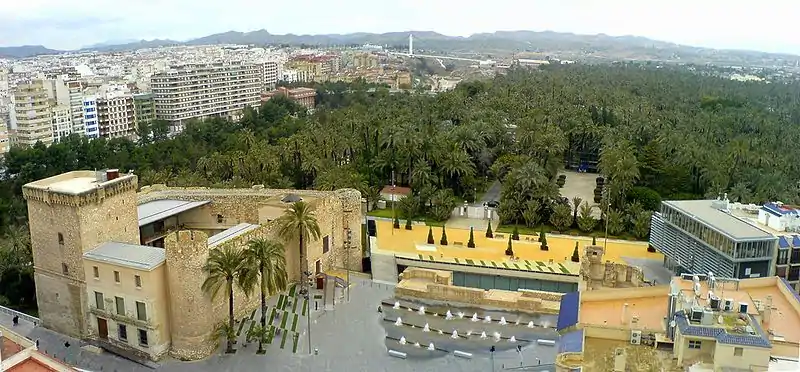 Altamira Castle and panoramic view of Elche | |
 Flag 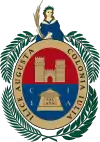 Coat of arms | |
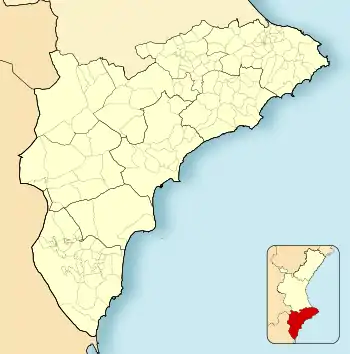 Elche Location in the Province of Alicante  Elche Location in the Valencian Community 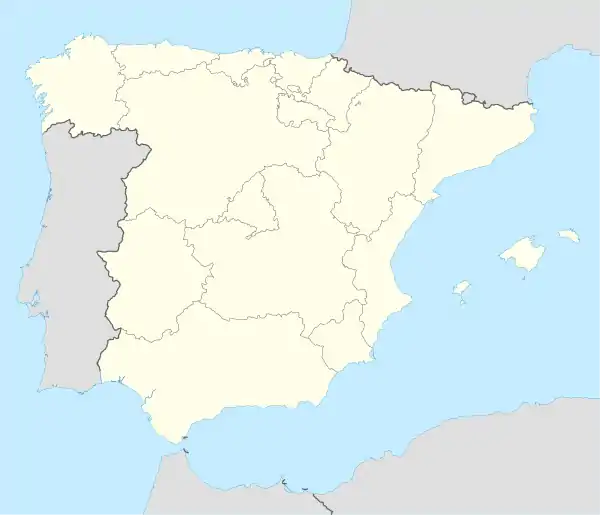 Elche Location in Spain | |
| Coordinates: 38°16′1″N 0°41′54″W | |
| Country | |
| Autonomous community | |
| Province | Alacant |
| Comarca | Baix Vinalopó |
| Judicial district | Elx |
| Founded | Iberian settlement; 5th century BC |
| Government | |
| • Alcalde (Mayor) | Carlos González Serna (2015) (PSPV-PSOE) |
| Area | |
| • Total | 326.10 km2 (125.91 sq mi) |
| Elevation | 86 m (282 ft) |
| Population (2018)[1] | |
| • Total | 230,625 |
| • Density | 710/km2 (1,800/sq mi) |
| Demonym(s) | Ilicitano, ilicitana |
| Time zone | UTC+1 (CET) |
| • Summer (DST) | UTC+2 (CEST) |
| Postal code | 03200-03299 |
| Dialing code | 966 - 965 |
| Official language(s) | Spanish and Valencian |
| Website | Official Website Official tourism Website |
Part of the municipality is coastal yet the city proper is roughly 11 km (6.8 mi) away from the Mediterranean Sea. A small creek called Vinalopó flows through the city.
Elche is so close to the city of Alicante that both cities form a de facto conurbation of some 800,000 inhabitants.
The city is noted by its urban Palm Grove, designated as World Heritage Site.
History
La Alcudia is 10 km from the current city's location and the immediate predecessor of current day Elche. This original location was settled by the Greeks and then occupied by Carthaginians and Romans. Greek Ionian colonists from the Achaean city Helike established their new colony, naming it Helíkē (Greek: Ἑλίκη) around 600 BC. It was a point of resistance against Carthaginian advance in Spain between the First and Second Punic Wars.[6][7] The Romans called the city Ilici or Illice and granted it the status of colonia;[7] after a brief Byzantine rule, the Goths took over, establishing an episcopal see.
_Jean_Laurent.jpg.webp)
Elche lost importance during the period of Moorish occupation, when it was moved slightly north to its present location. James II of Aragon took the city from the Moors in the 13th century, during the Reconquista.[7] The city grew throughout the 18th century[8] and became more important during the 19th century with the arrival of the railway and a booming industrial development of what used to be the traditional footwear industry.
Many archaeological remains have been found in Elche, with the stone bust of the Lady of Elche (Dama de Elche/Dama d'Elx in Spanish and Valencian (or Catalan), respectively) being the most important. This may date from the Iberian period (4th century BC). The original is in the National Archaeological Museum of Spain.[9][10]
Geography
It shares borders with Santa Pola, Guardamar del Segura, San Fulgencio, Dolores, Catral, Crevillent, Aspe, Montforte del Cid and Alicante. The most remarkable landform is Vinalopó River.[11]
According to the Spanish Stadistical Institute, there are 20 localities in the municipality besides the main town. The main town had a population of 190,821 in 2019 The number of people livin in the other localities came up to 41,821 in the same year. Algoda was home to 2,650 people, Algorós has a population of 638, Altabix was inhabited by 2,829 people, El Altet was home to 5,750 people Atsavares was home to 1,328 people, Asprella had a population of 403, Las Bayas was home to 2,975 people, Carrús was inhabited by 1,300 people, Daimés had a population of 1,190, El Derramador was home to 419 people, La Foia was inhabited by 2,804 people, Jubalcoi had a population of 1,215, El Pla de Sant Jose was home to 2,411 people, Maitino was inhabited by 890 people, La Marina had a population of 2,008, La Perleta was home to 1,376 people, Puçol was inhabited by 900 people, Torrellano had a population of 7,480, Vallverda was home to 1,767 people and Los Arenales del Sol was inhabited by 2,019 people.[12][13]
The local government also acknowledges Matola, which is part of Algoda according to the Spanish Stadistical Institute; Penya de les Àguiles, which is part of El Pla de Sant Josep accoding to the same institution, and Santa Anna, which is not recognised by the Stadistical Institute.[14]
Demographics
10.497% inhabitants are foreigners – 3.267% come from other countries of Europe, 3.369% are African, 2.46% are American, 1.139% are Asian and 15 people from Oceania and stateless people reside in the municipality.[15] The table below shows the population trend of 20th and 21st centuries by the beginning of their decades.[16]
| 1900 | 1910 | 1920 | 1930 | 1940 | 1950 | 1960 | 1970 | 1981 | 1991 | 2001 | 2011 | |
|---|---|---|---|---|---|---|---|---|---|---|---|---|
| Population | 127,308 | 30,511 | 33,167 | 38,013 | 46,596 | 55,877 | 73,320 | 122,663 | 162,873 | 188,062 | 198,190 | 230,354 |
Economy
The economy of Elche is based, in large part, on the footwear industry, with over 1,000 shoe factories, being one of the most important footwear centres in Spain and the rest of Europe with brands like Pura Lopez or Panama Jack.[17] There are other economic activities in Elche: agriculture (dates, olives, cereals and pomegranates), although it has lost importance in recent years; rubber industry;[18] trade, which employs 20% of the workforce; and tourism.
Elche has a conference centre (called Ciutat d'Elx), an international airport (Aeropuerto de Alicante) a public University, Universidad Miguel Hernández, and a private University, Universidad CEU Cardenal Herrera.
Climate
Elche has a hot semi-arid climate (Köppen climate classification: BSh) close to a desert climate (BWh)[19][20] with mild, dry winters and hot, dry summers.
| Climate data for Alicante–Elche Airport, 1981-2010 normals, 1967-2020 extremes | |||||||||||||
|---|---|---|---|---|---|---|---|---|---|---|---|---|---|
| Month | Jan | Feb | Mar | Apr | May | Jun | Jul | Aug | Sep | Oct | Nov | Dec | Year |
| Record high °C (°F) | 29.3 (84.7) |
29.2 (84.6) |
34.8 (94.6) |
33.6 (92.5) |
38.0 (100.4) |
38.9 (102.0) |
41.4 (106.5) |
39.8 (103.6) |
39.8 (103.6) |
34.3 (93.7) |
31.0 (87.8) |
27.0 (80.6) |
41.4 (106.5) |
| Average high °C (°F) | 16.7 (62.1) |
17.4 (63.3) |
19.4 (66.9) |
21.1 (70.0) |
23.8 (74.8) |
27.6 (81.7) |
30.1 (86.2) |
30.7 (87.3) |
28.5 (83.3) |
24.7 (76.5) |
20.3 (68.5) |
17.3 (63.1) |
23.2 (73.8) |
| Daily mean °C (°F) | 11.6 (52.9) |
12.3 (54.1) |
14.0 (57.2) |
15.9 (60.6) |
18.9 (66.0) |
22.8 (73.0) |
25.5 (77.9) |
26.1 (79.0) |
23.8 (74.8) |
19.8 (67.6) |
15.4 (59.7) |
12.5 (54.5) |
18.2 (64.8) |
| Average low °C (°F) | 6.5 (43.7) |
7.1 (44.8) |
8.7 (47.7) |
10.7 (51.3) |
13.9 (57.0) |
18.0 (64.4) |
20.8 (69.4) |
21.5 (70.7) |
19.0 (66.2) |
14.9 (58.8) |
10.6 (51.1) |
7.5 (45.5) |
13.3 (55.9) |
| Record low °C (°F) | −2.6 (27.3) |
−1.4 (29.5) |
−0.9 (30.4) |
1.7 (35.1) |
6.4 (43.5) |
10.3 (50.5) |
13.6 (56.5) |
14.0 (57.2) |
10.0 (50.0) |
5.0 (41.0) |
−0.2 (31.6) |
−3.8 (25.2) |
−3.8 (25.2) |
| Average rainfall mm (inches) | 21 (0.8) |
20 (0.8) |
20 (0.8) |
27 (1.1) |
28 (1.1) |
10 (0.4) |
4 (0.2) |
5 (0.2) |
40 (1.6) |
46 (1.8) |
34 (1.3) |
22 (0.9) |
277 (10.9) |
| Average rainy days (≥ 1 mm) | 3.6 | 2.9 | 3.1 | 3.7 | 3.7 | 1.6 | 0.7 | 0.9 | 3.3 | 4.1 | 3.8 | 3.7 | 35.1 |
| Average relative humidity (%) | 61 | 61 | 60 | 57 | 59 | 58 | 59 | 61 | 63 | 64 | 63 | 61 | 61 |
| Mean monthly sunshine hours | 184 | 179 | 221 | 251 | 291 | 316 | 344 | 313 | 243 | 218 | 174 | 165 | 2,953 |
| Source: Agencia Estatal de Meteorología[21][22][23] | |||||||||||||
Main sights


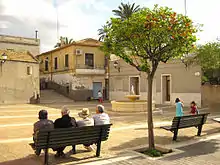
- Palmeral of Elche ("The Palm Grove of Elche", Palmerar d'Elx in Valencian (or Catalan)). It is an orchard of over 200,000 palm trees that was declared a World Heritage Site by UNESCO in 2000.[24]
- Altamira Castle, also known as Alcázar de la Señoría, located next to the Municipal Park (which, in turn, is a part of the Elche Palm Grove) It was originally built in Almohad times (12th-13th centuries), and was later renovated with brick exterior in the 15th century. A former fortress, in 1913 it became a fabric plant, it has also been used as the town hall and as a prison during the Spanish Civil War, while today is home to the Elche Archaeology and History Museum.[25]
- Baños Arabes (Arabic Baths), which re-uses old Roman baths.
- Basilica of Santa Maria: The current temple was built in 1672. Previously, there were other temples in the same place, but they disappeared owing to several factors. It has a la Latin-cross plan, a large navel and four side chapels. A large dome has been constructed over the crossing.[26][27]
- Calahorra Tower, of rectangular plan and Rabic origin, it represent the last relic of the old city walls.[28]
- Municipio (Town Hall): it includes a tower named la torre del consell, and it is the most ancient structure in the south of the Valencian Community. It was built in the mid-15th century.[29]
- Convento de la Merced: it was built in a place where there were arabic baths. It dates back to 1270, when the prince Juan Manuel bestowed the baths to the grand master of a religious order.[30]
- Huerto del Cura: it is part of the Palmeral of Elche and hosts nearly 500 palm trees. There are individuals of the imperial palm species.[31]
- Elche Palaeontological Museum: more than 1,200 fossils are on display in the museum. Some elements such as remains of mastodons and replicas of dinosaurs are placed in the building.[32]
- Elche Municipal Festa Museum: it was built in 1997 and it hosts elements about the Misteri d'Elx performance.[33]
- Palm Groves Museum: This museum is allocated in a traditional 19th century building. This museum is devoted to the history, the evolution and the characteristics of the Palmeral of Elche.[34]
The Mystery Play of Elx (better known as Misteri d'Elx, in Valencian (or Catalan)) is a sacral-lyrical medieval drama, dated from the 15th century, which was declared a Masterpiece of the Oral and Intangible Heritage of Humanity by UNESCO in 2002. It is played every year in mid August, in the context of the local holidays dedicated to the Assumption of Virgin Mary.[35] Also as a part of this celebration, on the 13th of August is the date of a celebration in Elche called Nit de l'Albà (Night of the Dawn) in which a citywide night-long show of fireworks takes place.
Transport
The Alicante–Elche Airport, the fifth-busiest in Spain is located in the municipality of Elche, around 10 kilometres (6.2 miles) east from the city centre. The Autopista AP-7 serves the outskirts of the city, and the railway linking Alicante and Murcia del Carmen runs through a tunnel underneath the city, with two underground stations; Elche-Parque (Valencian: Elx-Parc) and Elche-Carrús (Valencian: Elx-Carrús).[36] These are served by line C–1 of the Cercanías Murcia/Alicante commuter rail service, along with Media Distancia trains between Valencia Nord station and Murcia.
The Madrid–Levante high-speed rail network is being extended to reach a new station named Elche-Matola, branching off from the line to Alicante near Monforte del Cid. The new AVE station will contain parking space for 500 cars and 50 motorcycles.[37]
Festivities
- Holy Week: as generally in Spain, several processions (festive religious parades) occur during the festive period.[38]
- Moros i Cristians: it occurs in the first fortnight of August. The theme of this festivity is the Muslim rule that occurred in the High Middle Ages and part of the Low Middle Ages and the battles which took place between Christians and Muslims as a consequence of this occupation. A more specific subject of this festivity is the Reconquista.[39]
- Nit de la Roà: it takes place in the mid August.[40]
- Christmas: A nativity scene is placed in the town and a living nativity scene also occurs during the festive period. A parade which theme is the Three Wise Men is also performed in the Epiphany's Eve (5 January).[41]
Notable people
- Marceliano Coquillat (1865–1924), architect.
- Saúl Ñíguez (b. 1994), a footballer.
- Aarón Ñíguez (b. 1989), a footballer.
- Sílvia Soler Espinosa (b. 1987), an ex-tennis player. She played in tournaments in the WTA. Her record position was semifinalist in the Strasbourg tour.[42]
- Francisco Mojica (b. 1963), a microbiologist noted for his research on the CRISPR gene editing technique.[43]
Twin towns
Notes
- Both names are official as Elx/Elche.
References
- Municipal Register of Spain 2018. National Statistics Institute.
- "Elche" (US) and "Elche". Oxford Dictionaries UK Dictionary. Oxford University Press. Retrieved 19 May 2019.
- "Elx". Collins English Dictionary. HarperCollins. Retrieved 19 May 2019.
- "Elche". Merriam-Webster Dictionary. Retrieved 19 May 2019.
- Elche supera ya los 228.300 habitantes, INFORMACION.es, December 31, 2008, Editorial Prensa Ibérica
- "Roman Policy in Spain", Harvard Studies in Classical Philology, p. 209.
- "Historia – VisitElche". VisitElche – Portal oficial de Turismo de la ciudad española de Elche. Retrieved 2021-01-15.
- "El siglo XVIII y las grandes realizaciones urbanísticas en Elche". blogs.UA (in Spanish).
- "La Dama de Elche – VisitElche". Retrieved 2021-01-23.
- "Lady of Elche". www.man.es. Retrieved 2021-01-23.
- "El ayuntamiento colabora en una campaña de limpieza del río Vinalopó e invita a los ilicitanos a participar en ella". Ajuntament d'Elx (in Spanish). 2017-03-30. Retrieved 2021-01-14.
- "INEbase / Demography and population /Municipal Register. Population by municipality /Nomenclature: Continuous Register Population by Population Unit / Results". INE. Retrieved 2021-01-10.
- "INEbase / Demography and population /Municipal Register. Population by municipality /Nomenclature: Continuous Register Population by Population Unit / Results". INE. Retrieved 2021-01-10.
- "Pedanies – Ayuntamiento de Elche" (in Catalan). Retrieved 2021-01-10.
- "Datos del padrón de Elche/Elx - Diputación de Alicante". Diputación de Alicante - Unidad de Documentación de Presidencia (in Spanish).
- "Datos demográficos de de Elche/Elx - Diputación de Alicante". Diputación de Alicante - Unidad de Documentación de Presidencia (in Spanish).
- "Elche y la industria del calzado" (PDF). Ajuntament d'Elx (in Spanish). pp. 1, 3. Retrieved 2021-01-14.
- "Industria. Informes estadísticos anuales Elche 2015" (PDF). Ajuntament d'Elx (in Spanish). p. 4. Retrieved 2021-01-15.
- "Valores climatológicos normales". AEMET. Retrieved 4 January 2021.
- Clima de Elche. Universidad Miguel Hernández
- "Valores climatológicos normales. Alicante-Elche Aeropuerto". AEMET. Retrieved 4 January 2021.
- "Valores extremos. Alicante-Elche Aeropuerto". AEMET. Retrieved 4 January 2021.
- https://twitter.com/AEMET_CValencia/status/1355210242171219968
- "The palm grove or Palmeral of Elche-Elx in Alicante. History and information | spain.info in english". Spain.info. Retrieved 2021-01-10.
- "Palacio de Altamira – VisitElche". Retrieved 2021-01-23.
- "Basilica of Santa María in Elche | spain.info in english". Spain.info. Retrieved 2021-01-10.
- "Basílica de Santa María – VisitElche". VisitElche – Portal oficial de Turismo de la ciudad española de Elche. Retrieved 2021-01-10.
- "Torre de la Calahorra – VisitElche". Retrieved 2021-01-10.
- "Ayuntamiento – VisitElche". Retrieved 2021-01-14.
- "Convento de la Merced – VisitElche". Elche: Oasis mediterráneo (in Spanish). Retrieved 2021-01-10.
- "El Huerto del Cura Garden. Elche. Information and sights | spain.info in english". Spain.info. Retrieved 2021-01-10.
- "Museo Paleontológico – VisitElche". VisitElche – Portal oficial de Turismo de la ciudad española de Elche. Retrieved 2021-01-12.
- "Museo de la Festa (o Misteri d'Elx) – VisitElche". VisitElche – Portal oficial de Turismo de la ciudad española de Elche. Retrieved 2021-01-15.
- "Museo del palmeral – VisitElche". VisitElche – Portal oficial de Turismo de la ciudad española de Elche. Retrieved 2021-01-15.
- "Misterio de Elche religious theatre. 11/08/2021. Fiestas in Elche | spain.info in english". Spain.info. Retrieved 2021-01-10.
- "El túnel que cambió Elche". Diario Información (in Spanish). 14 October 2018. Retrieved 3 April 2020.
- "Dos horas y media de Elche a Madrid, en AVE". Diario Información (in Spanish). 4 February 2019. Retrieved 29 August 2019.
- "Semana Santa de Elche 2019 - La Guía W - La Guía Definitiva - Encuentra lo que quieras, donde quieras" (in Spanish). Retrieved 2021-01-12.
- "Moros y Cristianos – VisitElche". VisitElche – Portal oficial de Turismo de la ciudad española de Elche. Retrieved 2021-01-11.
- "Nit de la Roà – VisitElche". VisitElche – Portal oficial de Turismo de la ciudad española de Elche (in Spanish). Retrieved 2021-01-11.
- "Programa Fiestas Navidad Elche 2018 - La Guía W" (in Spanish). Retrieved 2021-01-15.
- "Silvia Soler se despide con una bonita carta: "Te quiero, tenis"". As (in Spanish). 2020-05-16. Retrieved 2021-01-23.
- "El español olvidado que vislumbró la técnica genética más importante del siglo". El Confidencial (in Spanish). 2016-01-16. Retrieved 2021-01-24.
- "Jumelages". Mairie de Toulouse.
- "La tristeza de una fuente seca". Canarias7. 8 May 2017.
- "Jaca y Elche consolidan su compromiso de colaboración" (PDF). El Pirineo Aragonés (6472): 1. 11 September 2009.
External links
| Wikimedia Commons has media related to Elx. |
| Wikivoyage has a travel guide for Elche. |
- Tour virtual 360° por la ciudad de Elche (in Spanish)
- Economical and social information about the city 2007 (in English)
- Ajuntament d'Elx, Town Hall of Elche (in Catalan and Spanish)
- Instituto Valenciano de Estadística City official statistics.
- Turisme d'Elx, City council official Tourist guide (in English, Catalan, and Spanish)
- Elche, City overview from a local citizen (in English)
- Cultura d'Elx, City council Cultural events website (in Catalan and Spanish)
- FuturElx, City council strategical development guidelines (in Spanish)
- The first ever Elche Home Page (in English)
- Miguel Hernandez University of Elche (in Catalan and Spanish)
- BBC Radio 3 programme on Mystery Play - available to listen online 14-21 October 2006 (in English)
- Festival of street arts Elx al Carrer (in Spanish)
- Museums of Elche (in Spanish)
